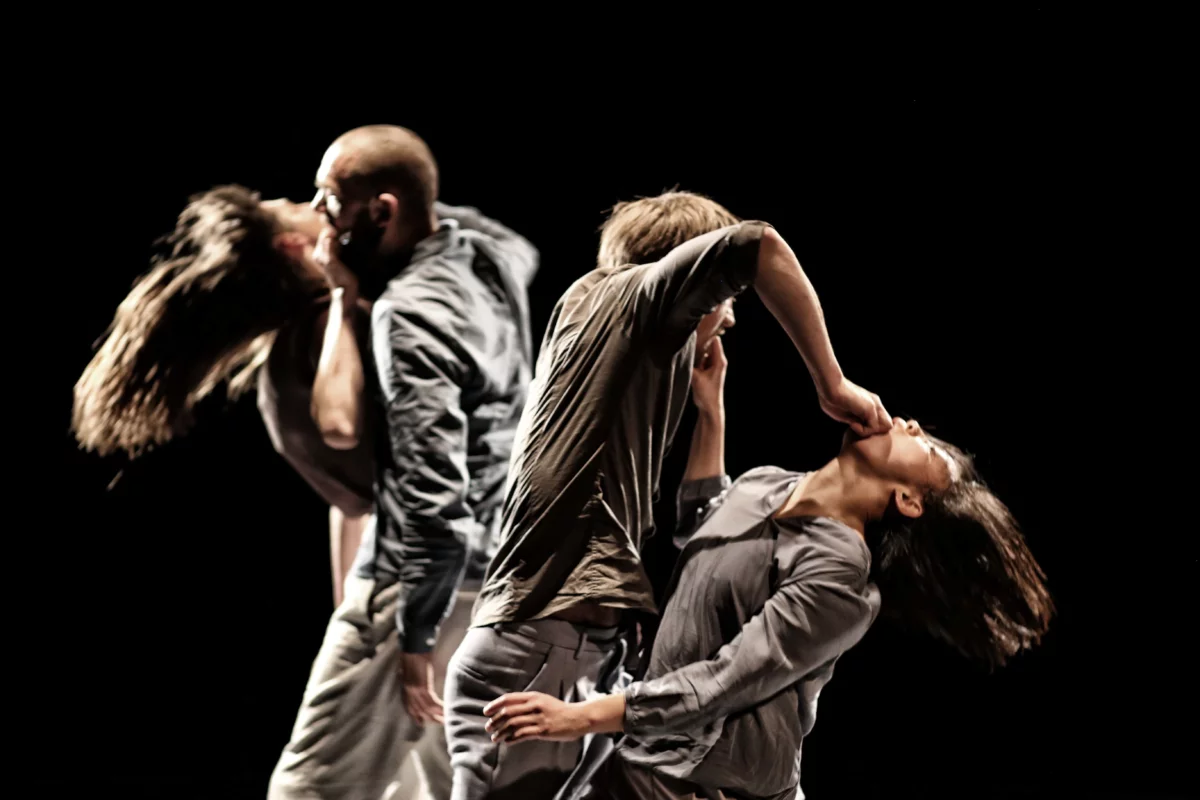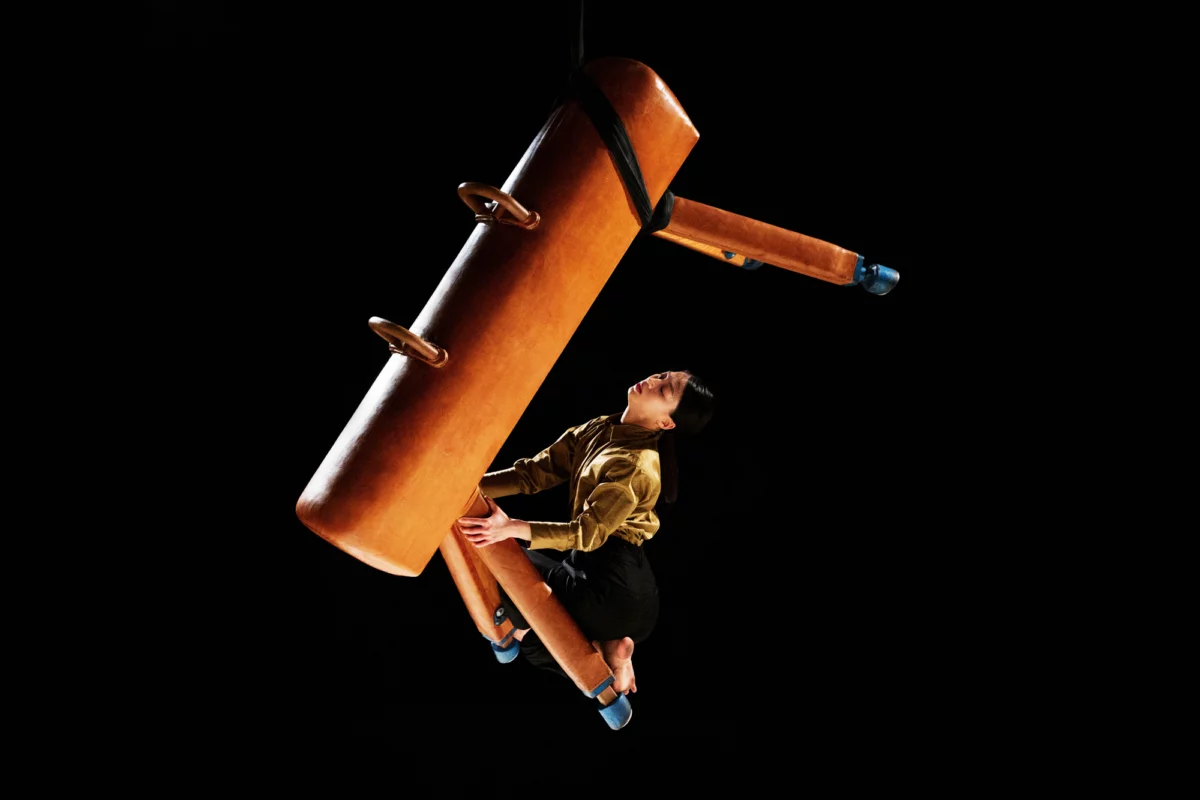Vertical Movement
By Tom Mustroph
Overhead Project combines acrobatics and contemporary dance. Cultural journalist Tom Mustroph in conversation with the winners of the Tabori Award (national) 2022.
Overhead Project was founded in 2008, in partnership, by trained acrobats Tim Behren and Florian Patschovsky. Tim Behren is now the artistic director. The company has created 15 productions and guest choreographies since its inception. The longtime core team includes composer Simon Bauer, lighting designer Charlotte Ducousso, performer Mijin Kim and producer Mechtild Tellmann. Behren is a co-founder of the Federal Association of Contemporary Circus and, in addition to his choreographic work, he is also the initiator and curator of the CircusDanceFestival in Cologne.
 © Ingo Solm
© Ingo Solm
Overhead Project "Surround"
Tim Behren, Overhead Project operates in between acrobatics and dance. How did this unusual connection come about?
The company started as a duo. Florian Patschovsky — my artistic partner for many years — and I trained together as an acrobatic duo at the École supérieure des arts du cirque in Brussels. Back in Germany we found our place in the dance scene and developed into a choreographer-duo. The Cologne scene offered us an open field for artistic work, there was good promotion for young talent and a lot of support from colleagues. This also opened the possibility of public funding for us, because there were no funding opportunities for contemporary circus. That has changed in the meantime. We see ourselves as a contemporary circus company, and at the same time I see myself as a choreographer and am firmly rooted in dance.
Where did the focus on dance come from?
For me, circus and dance are very close, much closer than circus and theatrical forms, for example. It's about movement and it's about the body. In addition, the circus school in Brussels is very influenced by the Flemish dance scene. We have been strongly influenced by acrobatic dance forms, such as those of Wim Vandekeybus. When we were at the circus school, there was also a strong focus on the connection to dance and exchange projects with Anne Teresa De Keersmaeker's partner school PARTS. And Brussels is simply a huge cultural metropolis. Many big companies from the international dance and circus scene come to perform there. I was able to see a lot at that time.
What are the biggest differences between a dancer's body and an acrobat's body? Which forms of movement are reflected differently in the body?
For me, dance works very much in the horizontal and the circus opens up the vertical, the air space. Acrobats think in other categories: What is possible, what can we do together, where can we climb, how can we carry ourselves? Playing with risk is yet another factor. For me, circus has something rough about it. In dance, on the other hand, articulation is more refined, it's about subtleties, details, nuances. And that actually combines quite nicely, the rough elements of circus and the subtlety of dance. For me, the encounter between dancers and acrobats in the rehearsal process is like that. It’s about mutual inspiration and the mixing of perspectives regarding space and the body.
And do the qualities of movement become blurred as a result? Or can you still see whether someone comes from contemporary dance or from acrobatics, even if they've worked together for several years by then?
In our work, the point is that this classification no longer exists, but that dancers and acrobats act together and you no longer see whether the person comes from acrobatics or dance. The division is not relevant for work in the studio or on stage, because the artistic language is a hybrid one. There is also music and the visual dramaturgy of lighting and stage design, which occupy an important place. The one thing it’s very important for me to say is that in contemporary circus the conditions we work in are also important if we want things to improve. Where can we find spaces that are not low-ceilinged like a dance studio, spaces with hanging points, where we can think in terms of height and hang heavy things from the ceiling?
 © Alessandro de Matteis
© Alessandro de Matteis
Overhead Project "Circular Vertigo"
The pommel horse plays a recurring role in your work. Not only in Circular Vertigo, the current production, but you have already used it in Surround. How did you come up with the idea of integrating such a rigid, large, clunky, difficult-to-move object into the work?
It actually came in as a metaphorical object. We've been working in trilogies since 2017. The first was Geometrie und Politik (Geometry and Politics), with the question of how spatial arrangements condition human communication. We developed three pieces for this, each with changing spatial settings. I'm always interested in spaces: how do they influence a situation, how do they shape communication hierarchies, and what role does the body play in them. We were inspired by architectural research on the floor plans of parliament buildings.
The first piece, Surround, was about the circle, about questioning this idea of the democratic that the circle embodies again and again: we sat within one circle, we spoke as equals, we were all visible. In the empty center of the circle, we wanted to hang an object from the ceiling that would attract attention. By swinging in the circle, it would define the space. That's what the pommel horse became, with its reference to traditional circus, with animals trotting in a circle, but also to memories of school sports as well as the rigidity of Olympic gymnastics. It is a very powerful, heavy object, in this case 100 kilograms, and you have to position yourself in relation to it. You can't escape it in any way. In Surround, this horse swings in a circle and forces both the performers, and later the audience, to physically relate to it; to position themselves. And that is something that interests me very much in artistic work, our creation of experiential spaces that result in physical spectatorship. Whether it's looking up into space, or the breeze that you feel on your skin when you swing the pommel horse. And not only is there a movement of air, but you know that the thing can knock you down if you don't move. It forces us to move, to position ourselves.
How great is the danger when such a large piece of gymnastics equipment comes spinning towards me?
Danger is also a theme in circus. At one point, of course, it's real. We work with that in order to test limits. And at the same time, it's always a calculated risk. It's not really about putting danger on display. It's more about a form of physical and mental presence that can be transmitted to the audience in a very physical way.
What are your typical performance venues? Are they among classic independent arts venues or are they also circus venues? How does that work?
We are at home in venues that are part of the independent scene, with partners like the Ringlokschuppen Ruhr, the LOFFT in Leipzig or the Mannheimer Eintanzhaus. But we now also have our own location on a circus showground in Cologne. Here we have the spatial and technical infrastructure we need. The company office is actually in a circus caravan. It's always a bit funny when I sit in the office in my caravan and tell people about contemporary circus via video conferences. Somehow it's also quite nice, because of course the new grows out of the old which always creates both friction and reference points. I find it exciting to invite people into a tent where they get to see something completely different to what the outer appearance suggests.
You are not only artistically active, but you’re also a voice for an artistic field, a scene. I've heard that the founding of the Initiative Neuer Zirkus (New Circus Initiative) basically started with you making a flyer to draw the attention of Cologne's cultural politicians to the circus initiatives that were already there. And this later led to the formation of a national association. Was the flyer really the founding moment? And what effect did it have?
That's exactly how it was. That was in 2011, we were a group of committed circus creators in Cologne who wanted to make their contemporary circus forms visible and wanted access to public funding. That kicked off the federal association BUZZ, which now has connections across Europe as a nationally recognized institution in this field. It still functions on a voluntary basis, which urgently needs to change. It is a driving force behind the fact that funding structures are now slowly changing in Germany and contemporary circus can establish itself as part of the performing arts.
Where do you see contemporary circus now, that is, also within the context of the independent performing arts? Is it a branch of that field? Do you want it to be, or is the relationship still different?
As an art form, contemporary circus is part of the performing arts. But on the other hand, don't we also have to rethink the way things are divided up into separate fields? The moment it comes to questions of eligibility for funding and entry into the public funding landscape, one automatically begins to devalue other forms, such as classical circus forms, because one wants to set oneself apart from them. The circus has already experienced this devaluation, as a low art form, in the 19th century. At that time, it was very popular and attracted masses of people. Circus is a historically incredibly exciting cultural phenomenon that is very strongly anchored in our collective memory, but is primarily characterized by its reception in painting, literature, music, pop culture and advertising. So today it's also about creating new images of circus. I think that, in the future, it is important to recognize circus as an intangible cultural heritage and to enable a conscious and critical approach to it. Especially with the colonial history of circus, which peaked with its history of exceptionalism and the presentation of marginalized and exotic creatures in the mid-19th century. Contemporary circus has the potential to create other images of circus and open up discussion and discourse.
How would you explain what contemporary circus is to people from the liberal and institutionalized performing arts who are ignorant of it and don't yet know what contemporary circus is?
That is the question. I usually start historically. Contemporary circus is still a very young but emerging art form in Germany, which has been developing in France and other neighboring European countries since the 1970s with corresponding structures and a large scene of artists. Pieces focus on the body and human-object relationships; artists like to shift their action space into the air and often seek very direct contact with the audience. It is an art form that surprises people, carries them away and inspires them. It is a form that does not take things too seriously and is not afraid to give a lot of space to the weird and sometimes even the funny. An art form that is worth discovering.
What does the Tabori Award mean to you, and perhaps to contemporary circus as a whole? And what hope do you associate with it?
This recognition is empowering. Especially for the continuous artistic work and development of the company. It is wonderful that this recognition goes to a participant in the field of contemporary circus and creates visibility in Germany for this art form we stand for. I would like to see more production houses as permanent partners for groups from contemporary circus. And the creation of more spaces in this country where productions like ours can be shown. One vision would be a choreographic center for circus in Germany based on the French model, which would support and promote the creation of, research for and performance of productions with circus-specific requirements.